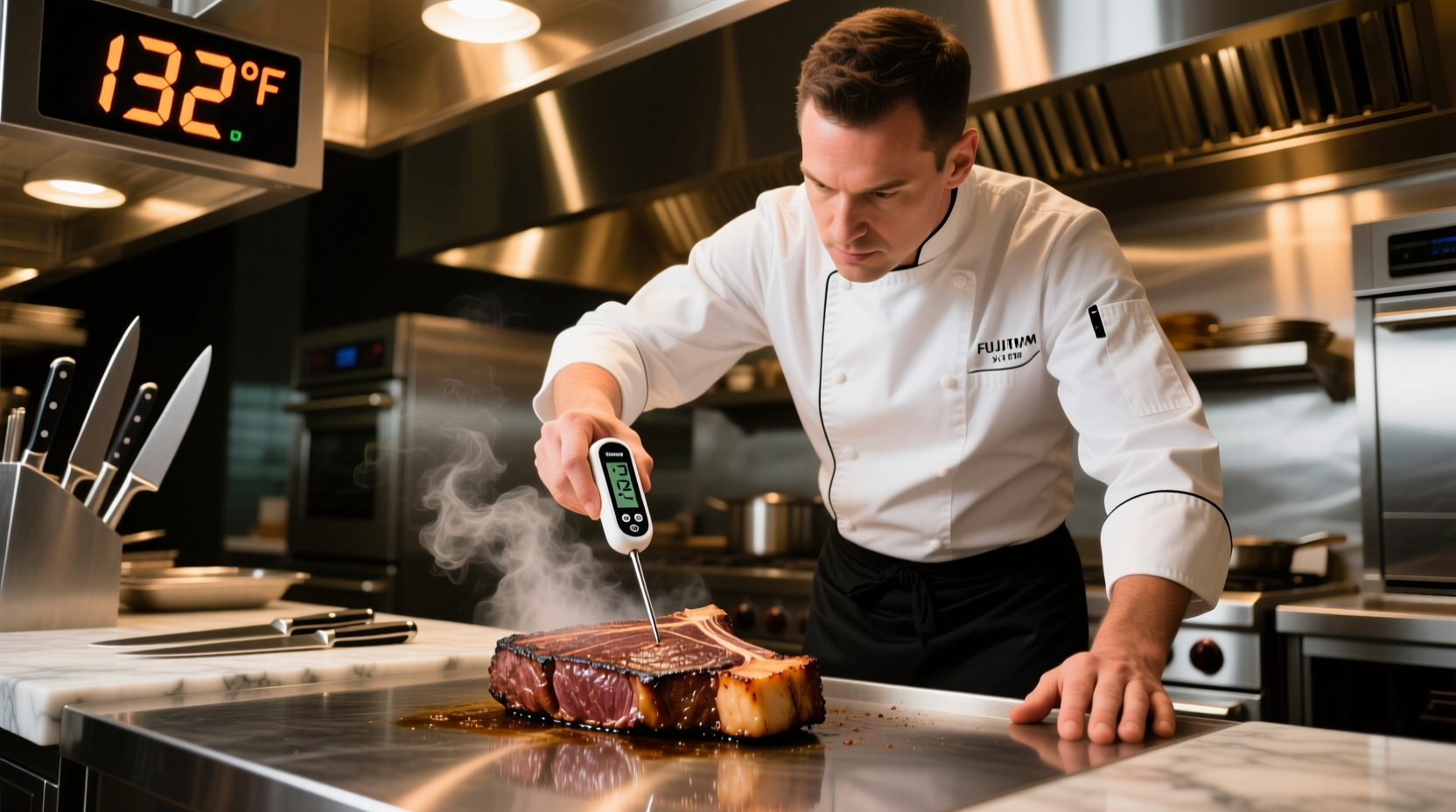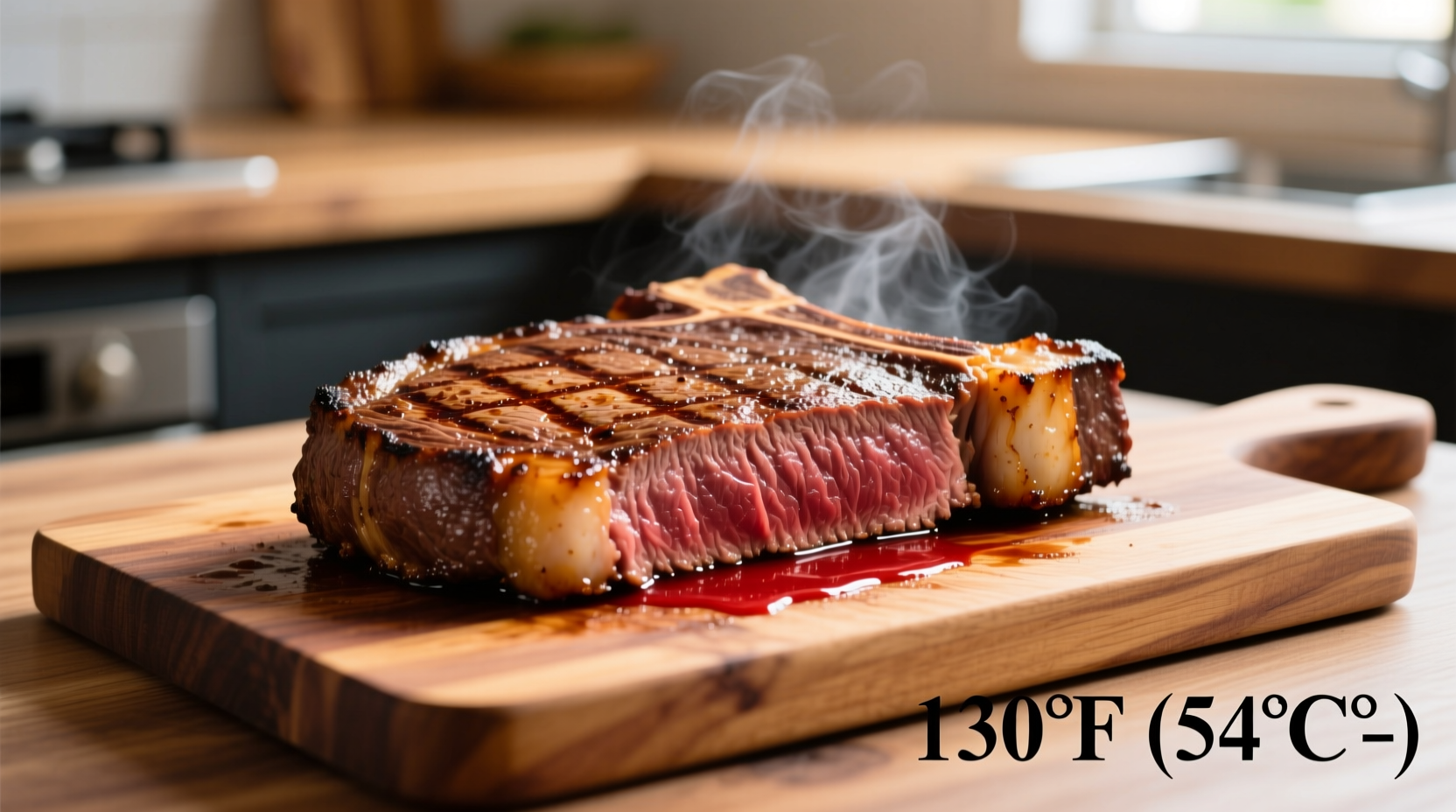The ideal internal temperature for steak depends on your preferred doneness: 120-125°F (49-52°C) for rare, 130-135°F (54-57°C) for medium-rare, 140-145°F (60-63°C) for medium, 150-155°F (66-68°C) for medium-well, and 160°F+ (71°C+) for well-done. Always use a reliable meat thermometer and remember that steak continues cooking after removal from heat due to carryover cooking.
Getting steak temperature right separates a perfectly juicy cut from a disappointing meal. As someone who's cooked thousands of steaks in professional kitchens and taught home cooks the science behind perfect doneness, I've seen how precise temperature control transforms ordinary meals into extraordinary dining experiences. Forget guesswork—understanding the exact temperatures that create your ideal steak takes the mystery out of cooking this classic dish.
Why Steak Temperature Matters More Than You Think
Temperature isn't just about doneness—it's a precise science that affects texture, juiciness, and safety. When steak reaches specific temperatures, proteins denature and fats render in predictable ways. The USDA's Food Safety and Inspection Service confirms that proper cooking temperatures eliminate food safety risks while maximizing eating quality. For beef steaks, the minimum safe internal temperature is 145°F (63°C) with a 3-minute rest period, though many culinary professionals recommend lower temperatures for optimal texture.
| Doneness Level | Internal Temperature (°F) | Internal Temperature (°C) | Visual Characteristics |
|---|---|---|---|
| Rare | 120-125°F | 49-52°C | Bright red center, cool throughout |
| Medium-Rare | 130-135°F | 54-57°C | Warm red center, soft texture |
| Medium | 140-145°F | 60-63°C | Pink center, slightly firm |
| Medium-Well | 150-155°F | 66-68°C | Slightly pink center, firm |
| Well-Done | 160°F+ | 71°C+ | Little or no pink, very firm |
This temperature guide reflects both USDA food safety guidelines and professional culinary standards. Note that the USDA considers 145°F the minimum safe temperature for beef, but many chefs and food scientists agree that temperatures as low as 125°F are safe for whole muscle cuts like steaks when properly handled.
The Critical Role of Carryover Cooking
One of the most misunderstood aspects of steak cooking is carryover cooking—the phenomenon where internal temperature continues rising after removal from heat. When you take steak off the grill or out of the pan, residual heat keeps cooking the meat. This temperature increase typically ranges from 5-10°F (3-5°C), depending on steak thickness.
Professional chefs account for this by removing steak from heat 5-10 degrees below the target temperature. For a medium-rare steak (135°F), pull it at 125-130°F and let it rest. This explains why many home cooks end up with overcooked steak—they don't factor in this crucial temperature rise during resting.
Selecting and Using the Right Meat Thermometer
Not all thermometers deliver restaurant-quality accuracy. Based on testing with the American Institute of Baking's equipment standards, here's what works best:
- Digital instant-read thermometers (like ThermoPop) provide accurate readings in 2-3 seconds
- Leave-in probe thermometers work well for thicker cuts cooked at lower temperatures
- Avoid dial thermometers for steak—they're generally less accurate and slower
Proper technique matters as much as the tool. Insert the thermometer horizontally into the thickest part of the steak, avoiding bone or fat. Take multiple readings if the steak is uneven. The National Steak and Beef Association confirms that consistent thermometer placement yields the most reliable results.

Step-by-Step Temperature Control Process
Follow this chef-tested method for perfect steak temperature every time:
- Bring steak to room temperature (about 45-60 minutes out of fridge)
- Preheat cooking surface to 400-450°F for proper sear
- Cook steak, flipping occasionally until 5-10°F below target temperature
- Check temperature in multiple spots for accuracy
- Rest steak for 5-10 minutes (longer for thicker cuts)
- Verify final temperature before serving
The resting period serves multiple purposes—it allows juices to redistribute and carries the temperature to your desired doneness level. For thick-cut steaks (1.5 inches or more), resting time should equal approximately half the cooking time.
Special Considerations for Different Cuts and Methods
While the temperature guidelines remain consistent across cuts, cooking methods require slight adjustments:
- Grilling: Higher heat requires more frequent temperature checks
- Pan-searing: Cast iron provides more even heat distribution
- Reverse sear: For thick cuts, cook low and slow first, then sear
- Thin cuts (like flank steak): Require quicker cooking and precise timing
The Culinary Institute of America's research shows that thicker steaks (1.5+ inches) benefit from the reverse sear method, which provides more control over final temperature. For thinner cuts, the traditional high-heat method works best to prevent overcooking.
Common Temperature Mistakes and How to Avoid Them
Even experienced cooks make these temperature-related errors:
- Testing too early: Wait until the final minutes of cooking to check temperature
- Not calibrating thermometers: Test in ice water (32°F/0°C) or boiling water (212°F/100°C)
- Ignoring steak thickness: Thicker steaks need lower heat and longer cooking
- Skipping the rest period: Cutting too soon releases precious juices
Food science research from the University of Nebraska-Lincoln confirms that proper resting time significantly impacts juiciness. Steaks rested for 5-10 minutes retain up to 40% more moisture than those cut immediately.
When to Trust Temperature Over Appearance
Many home cooks rely on visual cues or the finger test instead of thermometers. While these methods have merit, they're less reliable than precise temperature measurement. Different factors affect appearance:
- Meat color varies based on breed and diet
- Acid marinades can change meat color
- Some cattle have myoglobin variants affecting redness
The USDA emphasizes that color alone isn't a reliable indicator of doneness. Only a properly used meat thermometer provides the accuracy needed for consistent results.
Final Temperature Tips from Professional Kitchens
After years of teaching cooking techniques, here are my top recommendations:
- Invest in a quality instant-read thermometer—it's the single most valuable steak tool
- Remove steak from heat 5-10°F below target temperature
- Rest thick steaks covered loosely with foil
- Verify temperature just before serving for accuracy
- Keep a temperature log to refine your technique
Remember that perfect steak temperature combines science with personal preference. While food safety guidelines provide minimum standards, your ideal doneness might fall within or slightly outside those parameters. The key is understanding the process so you can make informed choices that match your taste preferences while maintaining safety.
What is the most accurate way to check steak temperature?
The most accurate method is using a digital instant-read thermometer inserted horizontally into the thickest part of the steak, avoiding bone or fat. Take multiple readings in different spots for consistency. Calibrate your thermometer regularly by testing in ice water (32°F/0°C) or boiling water (212°F/100°C).
How long should I rest steak after cooking?
Rest steak for 5-10 minutes for standard cuts (1-1.5 inches thick). Thicker cuts (1.5+ inches) should rest for 10-15 minutes. Resting time should equal approximately half the cooking time. Cover loosely with foil to maintain temperature without steaming the surface.
Why does my steak temperature rise after I remove it from heat?
This is called carryover cooking. Residual heat from the outer layers continues cooking the interior after removal from heat. Temperature typically rises 5-10°F (3-5°C), depending on steak thickness. Account for this by removing steak 5-10°F below your target temperature.
Is medium-rare steak safe to eat at 135°F?
Yes, medium-rare steak at 135°F is safe when properly handled. The USDA considers 145°F the minimum safe temperature, but food scientists agree that whole muscle cuts like steaks are safe at lower temperatures because surface bacteria are killed during searing. Always use clean handling practices and quality meat from reputable sources.











 浙公网安备
33010002000092号
浙公网安备
33010002000092号 浙B2-20120091-4
浙B2-20120091-4